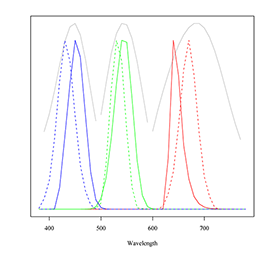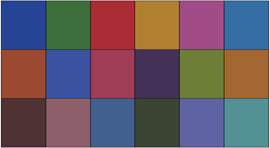The previous chapters about scanners and recorders describe their tonal characteristic, which is typically a linear translation of density. Scanning and recording color negative film, however,. raises the question of how the color information is transported. The densities of the three layers in a color negative neither correspond directly to the colorimetry of the original scene, nor do they correspond directly to the colorimetry of the final print. So, how should a film scanner translate the color information in a negative into digital values?
In traditional film post production, the negative is optically copied onto print film. The layers in the print film have a specific sensitivity to the electromagnetic spectrum that constitutes the sensation of colors. Optical printing is an image-capture process where the print film “sees” the negative illuminated by the printer light source. What the print film “sees” depends on the red, green, and blue spectral sensitivities and the spectral power distribution of the light source. The product of spectral sensitivity and spectral power distribution is called spectral response.
For control of laboratory processing the density of color negatives is measured with Status M densitometers. Status M is a spectral response standardized by the International Standards Organisation (ISO). The problem with Status M is that is does not match the typical spectral response of the motion picture print process.
Imagine a densitometer having a light source that is spectrally identical to the printer light source and red, green, and blue light sensors having spectral sensitivities identical to those of the print material. Such a densitometer would directly measure printing densities, those are densities as “seen” by the print film. In practice, such specialized densitometers are not used.
The SMPTE released a set of spectral response curves with [the practical goal … to require that the printing density measurements correctly specifies the printing gammas of typical motion-picture color negative and intermediate materials]. An exact duplication of the actual spectral response is not possible because of the large variety of printers and materials that exist.
It seems to be a good concept to design the spectral response of film scanners accordingly to the spectral response of the motion picture print process. Admittedly, a scanner manufacturer has to consider other factors as well, like dynamic range, signal to noise ratio, scanning speed, and costs. Under those constraints, it may not be possible to produce the desired spectral response with the light sources and digital imaging sensors available.
Since each negative has a limited number of image-forming dyes one can establish a transformation from the actual spectral response of the scanner to the desired response. In this case, however, the scanner would require a different transformation for each type of film, that is, for each negative film having a different set of dyes.
ARRI calibrates each single scanner for twenty different film stocks currently made by Kodak and Fuji. The user can choose whether the scan should represent Status M density or Printing Density. An additional advantage of this calibration is that it minimizes differences between individual units caused by variations in the light sources.
Figure B.2 shows typical results of the ARRISCAN calibration. The “raw“ scan looks neither like a Printing Density scan nor like a Status M scan, but the “raw“ scan can be transformed to produce a close match to each of the targets. The match is not perfect but one should remember the SMPTE Printing Density is not an exact duplication of the actual spectral response of the optical printer.
In Figure B.1, one recognizes that Printing Density “sees“ more red density than Status M. The overall look of a scan made using Printing Density will be warmer than that of a scan made using Status M spectral response. In many applications, Printing Density has been approximated by raising the red gamma of Status M data. This is demonstrated also in Figure B.2.
Scanning and recording moves the images from camera negative to intermediate film stock. If this process translates the printing densities correctly, a print from the internegative will match a print from the original negative. It was mentioned before that a film recorder needs to be calibrated in regular intervals. This is usually done by recording a series of patches that vary from minimum to maximum density. Since there are no densitometers measuring SMPTE Printing Density, density is measured as Status M.
Most users of the ARRILASER calibrate the recorder with Status M density measurements. As an approximation to printing density the red gamma is lowered on the recorder. One usual calibration aim for the maximum code value in 10 bit log data is 1.89 for red and 2.046 for green and blue, this is called the “Carlos Aim“. Other facilities use the “Kodak Aim“, which is 1.99, 2.16, 2.17. All values are Status M density.

